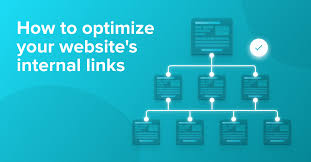Internal Linking Recommendations || Wordpress || AI Website
Internal Linking Recommendations for WordPress: Boost SEO & User Engagement
In the vast digital landscape, internal linking is one of the most underrated yet powerful SEO strategies. If you're running a WordPress website and ignoring internal linking, you're missing out on higher rankings, better user engagement, and increased page authority.
But what exactly are internal linking recommendations, and how can you optimize them for WordPress?
In this ultimate guide, we’ll explore:
✔ What is Internal Linking & Why It Matters
✔ Best Practices for Internal Linking in WordPress
✔ Common Mistakes to Avoid
✔ Advanced Strategies to Supercharge Your SEO
By the end, you’ll have a step-by-step blueprint to transform your website’s internal linking structure for maximum traffic and conversions.
1. What is Internal Linking? (And Why Should You Care?)

Internal linking refers to linking one page of your website to another page on the same domain. Unlike external links (which point to other websites), internal links help:
✅ Improve SEO (Google crawls & indexes pages faster)
✅ Enhance User Experience (keeps visitors engaged longer)
✅ Spread Link Equity (boosts authority of important pages)
✅ Reduce Bounce Rate (encourages visitors to explore more content)
The Hidden Power of Internal Links
Imagine your website as a city, and internal links are the roads connecting different neighbourhoods. Without proper roads, people (and search engines) get lost.
But with a well-planned linking strategy, you:
✔ Guide users to high-value content
✔ Help Google understand your site’s hierarchy
✔ Increase time-on-site, which signals quality to search engines
2. WordPress Internal Linking Best Practices (Actionable Tips)
🔹 1. Use Descriptive & Natural Anchor Texts
Avoid generic phrases like:
❌ "Click here"
❌ "Read more"
Instead, use keyword-rich anchor texts that describe the linked page:
✅ "Learn how to optimize WordPress speed"
✅ "Check out these SEO plugins for WordPress"
Why?
Google uses anchor text to understand the context of the linked page.
🔹 2. Link Deep, Not Just to the Homepage
Many bloggers only link to their homepage or popular posts, but this is a missed opportunity.
Instead:
✔ Link to related blog posts
✔ Link to product pages (if you run an eCommerce site)
✔ Link to pillar content (ultimate guides, tutorials)
Example:
If you’re writing about "Best WordPress Themes", internally link to:
"How to Install a WordPress Theme"
"Free vs. Premium WordPress Themes"
🔹 3. Follow the "3-Link Rule" (A Unique Strategy!)
Most SEOs recommend adding 3-5 internal links per post, but here’s a twist:
🔴 1st Link → Pillar Content (Your most authoritative guide)
🟠 2nd Link → Supporting Blog Post (Related topic)
🟢 3rd Link → Call-to-Action (CTA) (Newsletter, product, or contact page)
This ensures a balanced approach—SEO, user engagement, and conversions.
🔹 4. Use WordPress Plugins for Smart Internal Linking
Manually adding links is tedious. Instead, use these WordPress plugins:
📌 Link Whisper → AI-powered internal linking suggestions
📌 Yoast SEO → Suggests related posts to link
📌 Internal Link Juicer → Automates internal linking
🔹 5. Fix Orphan Pages (A Silent SEO Killer!)
Orphan pages are pages with no internal links pointing to them.
How to Find & Fix Them?
✔ Use Google Search Console → Check "Coverage" reports
✔ Use Screaming Frog SEO Spider → Crawl your site
Once found, add internal links from relevant posts to these orphan pages.
3. Common Internal Linking Mistakes (Avoid These!)
❌ 1. Overlinking (Spammy & Hurts UX)
Adding too many links in a single post looks spammy and confuses readers.
Solution: Keep it natural—3-5 relevant links per 1000 words.
❌ 2. Linking to Low-Quality Pages
If you link to thin or irrelevant content, users (and Google) will lose trust.
Solution: Only link to high-quality, relevant pages.
❌ 3. Using Broken Links
Broken links (404 errors) harm user experience and SEO.
Fix: Use Broken Link Checker plugin to detect & fix them.
4. Advanced Internal Linking Strategies (Next-Level SEO)
🚀 1. The "Hub & Spoke" Model
Hub Page = Ultimate Guide (e.g., "WordPress SEO Guide")
Spoke Pages = Related Posts (e.g., "Best SEO Plugins," "How to Optimize Images")
How It Works:
✔ All spoke pages link back to the hub page
✔ Hub page links to all spoke pages
This creates a strong SEO silo, boosting rankings for the main topic.
🚀 2. Internal Links for Featured Snippets
Google often pulls featured snippets from well-linked pages.
Tactic:
Find questions your post answers (use Answer The Public)
Link to that section using #jump links (e.g., "#best-wordpress-plugins")
🚀 3. Dynamic Internal Linking with AI
Tools like Link Whisper and Surfer SEO analyze your content and suggest smart internal links automatically.
5. Final Checklist for WordPress Internal Linking
Before publishing any post, ask yourself:
✔ Did I use keyword-rich anchor texts?
✔ Did I link to deep pages (not just homepage)?
✔ Did I follow the 3-Link Rule?
✔ Did I fix orphan & broken links?
✔ Did I use a hub-and-spoke structure?
Conclusion:
Master Internal Linking & Dominate SEO
Internal linking isn’t just an SEO tactic—it’s a growth strategy. When done right, it:
✔ Boosts rankings by helping Google crawl your site
✔ Engages users by guiding them to valuable content
✔ Converts visitors by leading them to CTAs
Action Step: Open your latest blog post right now and apply at least 3 internal links using the strategies above.
💡 Pro Tip: Bookmark this guide and revisit it every time you publish a new post to keep your internal linking game strong!
What’s your biggest challenge with internal linking? Let me know in the comments! 🚀









Comments
Post a Comment